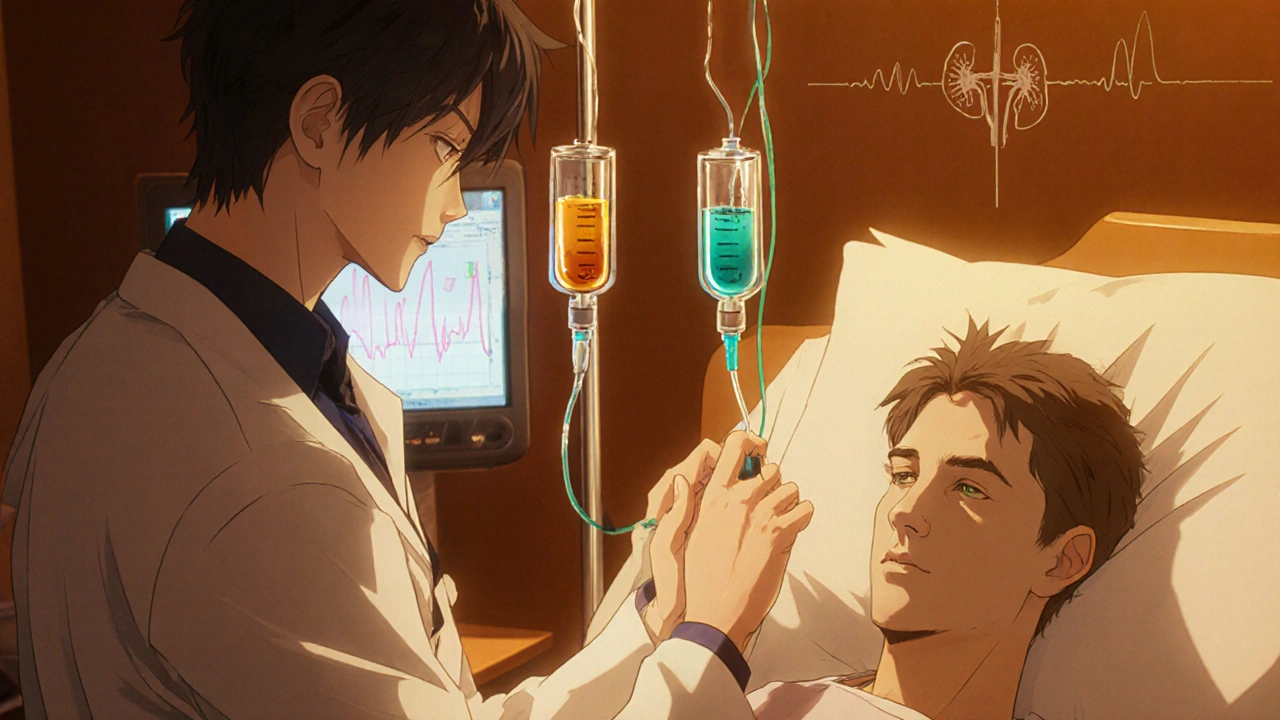Ampicillin Renal Dosing Calculator
Dosing Guide
For brucellosis treatment, ampicillin dosing requires adjustment in renal impairment. Based on CDC and WHO guidelines:
- Normal renal function: 2g IV every 6 hours
- CrCl < 30 mL/min: 1g IV every 8 hours or every 12 hours
- Monitor: Serum creatinine every 48 hours during therapy
Enter your patient's creatinine clearance to see recommended dosing.
When it comes to battling brucellosis, Ampicillin is often overlooked, yet it can be a useful weapon in the clinician’s arsenal. Ampicillin is a beta‑lactam antibiotic belonging to the penicillin family. It works by inhibiting bacterial cell‑wall synthesis, leading to cell death. Brucellosis is a zoonotic infection caused by Brucella species that transmit from animals to humans through unpasteurized dairy, direct contact, or inhalation. The disease presents with undulating fever, sweats, joint pain, and can become chronic if not treated properly. Understanding where ampicillin fits among the many antibiotic options is essential for anyone managing this infection.
Why Ampicillin Matters in Brucellosis Therapy
Most guidelines recommend a combination of doxycycline with rifampin or streptomycin as first‑line therapy. However, certain scenarios-such as pregnancy, allergy to doxycycline, or renal impairment-push clinicians to consider alternative regimens. Ampicillin’s safety profile during pregnancy and its renal clearance make it a candidate when doxycycline is contraindicated. Moreover, its synergistic effect with aminoglycosides can boost bacterial killing, especially for Streptomycin, an injectable used in severe brucellosis cases.
Pharmacology Snapshot
After an intravenous or intramuscular dose, ampicillin reaches peak plasma concentrations within 30‑60 minutes. It distributes well into most body fluids, including cerebrospinal fluid when the meninges are inflamed-a crucial point for neurobrucellosis. The drug is primarily excreted unchanged by the kidneys, so dose adjustments are needed for patients with a creatinine clearance below 30 mL/min. Its half‑life ranges from 1‑1.5 hours in healthy adults to 3 hours in renal failure.
Recommended Dose Regimen for Brucellosis
While data specific to brucellosis are limited, clinicians often borrow from the treatment of other gram‑negative infections. A common regimen is:
- Ampicillin 2 g IV every 6 hours (or 1 g IV every 6 hours for patients with moderate renal dysfunction).
- Combine with gentamicin 5 mg/kg IV once daily for the first 7‑10 days, then continue ampicillin alone for a total of 6 weeks.
Therapeutic drug monitoring for gentamicin helps avoid nephrotoxicity, a risk that rises when ampicillin’s renal clearance is already compromised.
Comparing Ampicillin with Other Common Regimens
| Antibiotic | Typical Dose (Adults) | Treatment Duration | Advantages | Drawbacks |
|---|---|---|---|---|
| Ampicillin | 2 g IV q6h | 6 weeks (with aminoglycoside for 1 wk) | Pregnancy‑safe, good CSF penetration, renal excretion | Requires IV, renal dosing, possible allergic reactions |
| Doxycycline | 100 mg PO bid | 6 weeks | Oral, broad‑spectrum, inexpensive | Contraindicated in pregnancy, photosensitivity |
| Rifampin | 600 mg PO qd | 6 weeks | Oral, penetrates intracellularly | Drug interactions, hepatotoxicity |
| Sterptomycin | 1 g IM daily | 2‑3 weeks (often with doxycycline) | Potent bactericidal | Ototoxicity, requires injection |
Choosing the right combo depends on patient factors, local resistance patterns, and drug availability. Ampicillin shines when oral options are off‑limits.

Safety Profile and Common Side Effects
Adverse reactions to ampicillin are generally mild and include:
- Gastro‑intestinal upset (nausea, diarrhea)
- Rash or urticaria
- Elevated liver enzymes (rare)
Severe hypersensitivity, such as anaphylaxis, occurs in Penicillin‑allergic patients and mandates a switch to a non‑beta‑lactam agent. Monitoring renal function every 48 hours during the intensive phase helps detect early nephrotoxicity, especially when a aminoglycoside is added.
Special Populations
Pregnant Women: Ampicillin crosses the placenta but has a long safety record, making it preferable to doxycycline, which is teratogenic.
Children: Dosing follows weight‑based calculations (200 mg/kg/day divided q6h). Pediatric formulations are available as powder for reconstitution.
Elderly: Age‑related decline in renal clearance often necessitates a 25‑30 % dose reduction.
Monitoring Treatment Success
Clinical improvement-defervescence within 2‑3 days and resolution of malaise-provides the first clue that therapy works. Laboratory follow‑up includes:
- Serologic titers (e.g., SAT or ELISA) every 2‑4 weeks; a four‑fold drop signals cure.
- Blood cultures at week 2 and week 4 for high‑risk patients.
- Liver and renal panels to catch drug‑induced injury.
Guidelines from the World Health Organization (WHO) and the Centers for Disease Control and Prevention (CDC) recommend a minimum of 6 weeks of therapy to minimize relapse, which hovers around 5‑10 % with optimal treatment.
Potential Pitfalls and How to Avoid Them
1. Skipping the aminoglycoside phase: Without the synergistic boost, ampicillin monotherapy has a higher relapse rate.
2. Ignoring renal dosing: Over‑dosing in renal failure can precipitate acute kidney injury.
3. Failure to assess drug allergies: A missed penicillin allergy can turn a routine course into a life‑threatening emergency.
4. Premature discontinuation: Stopping before 6 weeks increases chronicity, especially in osteo‑articular disease.

Practical Tips for Clinicians
- Always obtain a detailed exposure history (livestock, unpasteurized cheese) to confirm suspicion of brucellosis.
- Use a combination regimen-ampicillin plus gentamicin or streptomycin-unless contraindicated.
- Document allergy status meticulously; consider skin testing if uncertainty exists.
- Educate patients on the importance of drug adherence; missed doses raise relapse risk.
- Schedule follow‑up serology at 4 weeks and again at 12 weeks post‑therapy.
Future Directions and Research Gaps
Most of the evidence for ampicillin in brucellosis stems from small case series and retrospective analyses. Ongoing trials in endemic regions aim to compare oral carbapenems and high‑dose ampicillin regimens head‑to‑head with the doxycycline‑rifampin standard. Additionally, pharmacokinetic‑pharmacodynamic modeling is refining dosing in patients with varying renal function, potentially shortening IV duration while preserving efficacy.
Bottom Line
ampicillin offers a viable, pregnancy‑friendly alternative for brucellosis, especially when combined with an aminoglycoside. Correct dosing, vigilant monitoring, and adherence to a six‑week total course are the pillars of success. By weighing patient‑specific factors-renal function, allergy profile, disease severity-clinicians can harness ampicillin’s strengths without falling into common traps.
Frequently Asked Questions
Can ampicillin be used alone for brucellosis?
Monotherapy with ampicillin is generally discouraged because relapse rates are higher. It works best when paired with an aminoglycoside like gentamicin or streptomycin for the intensive phase.
Is ampicillin safe during pregnancy?
Yes. Ampicillin belongs to the penicillin class, which is classified as Category B by the FDA. It does not show teratogenic effects and is preferred over doxycycline for pregnant patients.
What are the key signs that brucellosis treatment is failing?
Persistent fever beyond 3‑4 days, rising serologic titers, and new focal symptoms (e.g., joint swelling) suggest inadequate response. Consider re‑evaluating the regimen, checking drug levels, and ruling out antibiotic resistance.
How should the dosage be adjusted for renal impairment?
For a creatinine clearance < 30 mL/min, reduce the dose to 1 g IV every 8 hours or extend the dosing interval to every 12 hours. Monitor serum creatinine every 48 hours during therapy.
What follow‑up tests are recommended after completing therapy?
Repeat serology (e.g., SAT) at 4 weeks and 12 weeks post‑treatment. A four‑fold drop in titer indicates cure. If symptoms recur, obtain blood cultures and imaging of involved sites.
